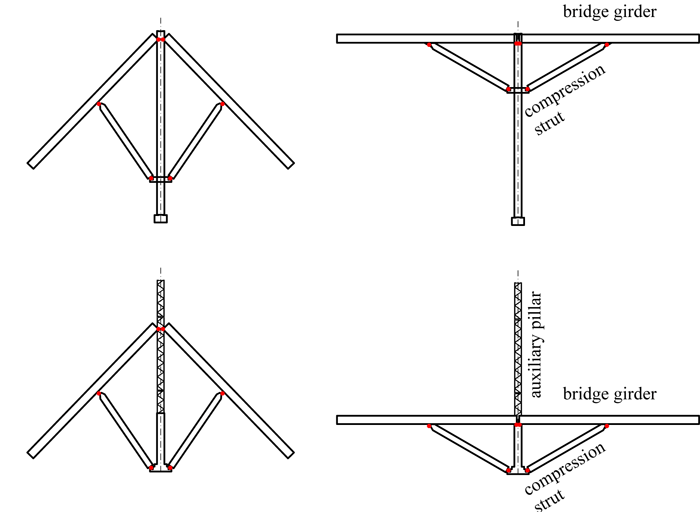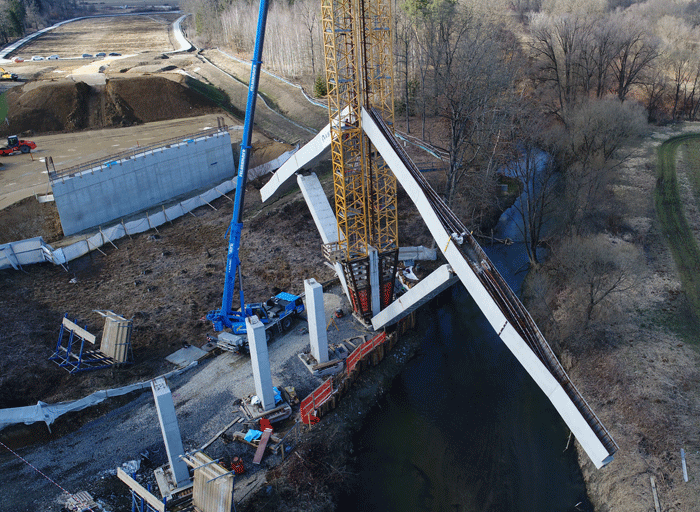
In February this year the balanced lowering method was successfully used during the construction of a new crossing over the Lafnitz River (pictured above). It is the second bridge near the town of Fürstenfeld in south-east Austria that is being constructed using a bridge-building method that has never been used before.
The two crossings are part of the new S7 highway under construction by Asfinag. The bridge crossing the Lahnbach was erected in several phases between October 2019 and January 2020. The first of four lowering processes for the longer bridge over the Lafnitz River took place on 27 February, 2020 (Bd&e no 61). The Lahnbach and Lafnitz structures are very similar, 100m and 116m long respectively, and each consists of two parallel crossings 14.5m wide. As they are located in an ecologically sensitive area, the construction methods that had initially been considered suitable were balanced cantilever or incremental launching methods. However, the untested balanced lift method was considered after it was shown that its costs would be 30% lower than the others. Large-scale tests that were carried out in 2010, at 70% scale of the S7 bridges, demonstrated its viability.

The balanced lift method is used for bridges with high piers and the balanced lowering method for bridges with piers of modest height
The method has two variants, which largely depend on the height of the piers in relation to the span lengths. Where piers are short, as is the case with the 8m-high S7 crossing piers, two bridge girders at either side of the pier are constructed in a vertical position, using a taller auxiliary pier (eg tower crane units) which acts as a guiding rail. The girders are deliberately lightweight to facilitate their movement during the lifting operation, and consist of hollow, thin-walled prefabricated concrete U-shaped elements – 70mm thick in the case of both S7 bridges – with steel reinforcement.
When constructed, the two girders are slightly tilted and four tendons installed that run through both girders over a central saddle between the top of both girders. Each girder is also linked to the pier with a vertical compression strut, using a movable joint positioned around mid-girder. The struts are built in a similar way to the girders but with thicker walls and top/bottom slabs to enable anchor cones for tie rods to be incorporated.
With all elements in place, hydraulic jacks push apart the compression struts while two lowering cables running through the girders are kept in tension. This causes the two girders and support struts to open up in an umbrella-like action, until the girders are horizontally aligned over the pier.
The thin-walled concrete elements, joints and struts are then covered or filled with concrete, creating a monolithic structure. The structure is completed with a conventional reinforced concrete deck slab. In cases where the piers are higher than the length of the required spans, the method is more advantageous as there is no need to erect an auxiliary structure on top of the pier.

First lowering operation on Lafnitz Bridge
The unfolded girders of the S7 bridges are each 54t in weight and 36m in length, resulting in a 72m span. Assembly of the Lafnitz Bridge’s girders took around four days, and the lowering process was completed in three hours, covering a distance of 26.5m. Once unfolded, the gaps between the girders and the abutments were closed with suspended girders.
The new method includes a system for adjusting the alignment of the girders. For Lafnitz Bridge, the span is required to have a 0.6% elevation, which was achieved through the use of two adjustment screws positioned at either side of the pier. Johann Kollegger of the Institute of Structural Engineering of TU Wien in Austria, who invented the method, says that using this technique a maximum adjustment of around 1% can be achieved. “But final alignment is always done with the post-tensioning cables. For Lafnitz Bridge we had to raise the one cantilever tip by 15mm and the other by 84mm,” he says.
Kollegger has been waiting for the opportunity to use this method for over ten years. It was originally inspired by the construction practice regularly used for arch bridges in Spain and Japan, which consists of lowering the arch halves until they meet in the middle. “The first one was Riccardo Morandi’s Lussia Bridge, a pedestrian arch bridge in Vagli Sotto, Italy.”
The new method is described as particularly suitable for crossings with high piers and span lengths in the range of 50-250m that are located in challenging terrain or sensitive areas, because it avoids the use of extensive scaffolding and formwork, which can take months – rather than days – to assemble. In addition, the compression struts in effect reduce the span length, allowing lower volumes of construction materials.

Four lowering operations have taken place on Lahnbach Bridge
The assembly process for the second bridge girder of Lafnitz Bridge was under way at the time of writing (end of April), following a delay due to corona-related restrictions.



